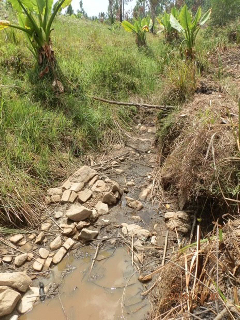Located on the southeast side of the island of Madagascar, the 67-hectare Ankepaka farm was intended to produce food for 300 children at the Lutheran School in Ankaramalaza (25 kilometers, 2 ½ hours away).
About ten families reside in Ankepaka, which, by the way, has no electricity and no school.
Last year, a relatively intricate pumping system was installed to move water from a slow-moving stream at the back of the farm up to the cattle shed, vegetable plots, and village clearing. Plans included placing fish cages in the stream. Farm laborers also hand-dug two cavities to be filled with water and used as fish ponds.
Back then, everyone asserted that the stream "never went dry." There’s been no appreciable rain for months. It’s gone dry. Our farm manager had to buy water, jerry can by jerry can.
Our partner wrote in late August regarding the situation in Ankaramalaza:
“This year there has been a great drought...No rain, no rice, no vegetables, no fruit. The cultivation of coffee has not been productive. Rice is expensive. In Ankaramalaza, it has been a difficult year, and young women [who previously learned knitting and crocheting for income] have had to work hard to contribute to the survival of the family.”
The 70 Ankepaka villagers have been through a lot and are too poor to simply move on to another place. For both garden plots and villagers, a predictable water supply is vital. We’ve contracted with a company to drill two borehole wells in Ankepaka: one in the village clearing, and one in the garden area.
